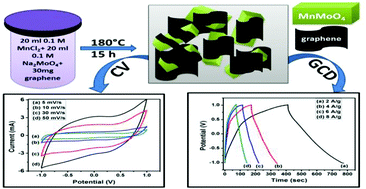α MnMoO4/graphene hybrid composite: high energy density supercapacitor electrode material†
Abstract
A unique and cost effective hydrothermal procedure has been carried out for the synthesis of hexahedron shaped α MnMoO4 and its hybrid composite with graphene using three different weight percentages of graphene. Characterization techniques, such as XRD, Raman and FTIR analysis, established the phase and formation of the composite. The electrochemical characterization of the pseudocapacitive MnMoO4 and the MnMoO4/graphene composites in 1 M Na2SO4 displayed highest specific capacitances of 234 F g−1 and 364 F g−1, respectively at a current density of 2 A g−1. Unlike many other pseudocapacitive electrode materials our prepared materials responded in a wide range of working potentials of (−)1 V to (+)1 V, which indeed resulted in a high energy density without substantial loss of power density. The highest energy densities of 130 Wh kg−1 and 202.2 Wh kg−1 were achieved, respectively for the MnMoO4 and the MnMoO4/graphene composite at a constant power delivery rate of 2000 W kg−1. The synergistic effect of the graphene with the pseudocapacitive MnMoO4 caused an increased cycle stability of 88% specific capacitance retention after 1000 consecutive charge discharge cycles at 8 A g−1 constant current density, which was higher than the virgin MnMoO4 with 84% specific capacitance retention.


 Please wait while we load your content...
Please wait while we load your content...